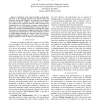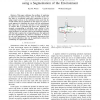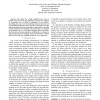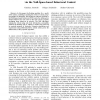ICRA
2007
IEEE
14 years 5 months ago
2007
IEEE
— Ubiquitous robots need the ability to adapt their behaviour to the changing situations and demands they will encounter during their lifetimes. In particular, non-technical user...
ICRA
2007
IEEE
14 years 5 months ago
2007
IEEE
Abstract— The human communication exists in various situations of our daily life. For human – robot communication or robot – robot communication, it is useful to design a com...
ICRA
2007
IEEE
14 years 5 months ago
2007
IEEE
— Coalescence is the problem of isolated mobile robots independently searching for peers with the goal of forming a single connected network. This is important because communicat...
CEC
2007
IEEE
14 years 5 months ago
2007
IEEE
Abstract— Designing effective behavioral controllers for mobile robots can be difficult and tedious; this process can be circumvented by using unsupervised learning techniques w...
IROS
2008
IEEE
14 years 5 months ago
2008
IEEE
— This paper addresses the problem of exploring an unknown environment with a team of mobile robots. The key issue in coordinated multi-robot exploration is how to assign target ...
IROS
2008
IEEE
14 years 5 months ago
2008
IEEE
— The desire for a high mobility-to-size ratio in mobile robots has led to the exploration of many new methods of locomotion, one of which is tumbling. To the authors’ knowledg...
IROS
2008
IEEE
14 years 5 months ago
2008
IEEE
— As the ability to produce a large number of small, simple robotic agents improves, it becomes essential to control the behavior of these robots in such a way that the sum of th...
IROS
2008
IEEE
14 years 5 months ago
2008
IEEE
Abstract— In this paper the flocking problem for a multirobot system, consisting in making the robots of a team grouping together, is addressed. The flocking is achieved resort...
ICRA
2008
IEEE
14 years 5 months ago
2008
IEEE
— This paper focuses on the assignment of discrete points to two robots, in the presence of geometric and kinematic constraints between the robots. The individual points have dif...
ICRA
2008
IEEE
14 years 5 months ago
2008
IEEE
— As part of a program to find methods of reducing spatial interference in multi-robot systems, we propose the Interaction Grid (IG), a generalization of the Occupancy Grid that...




